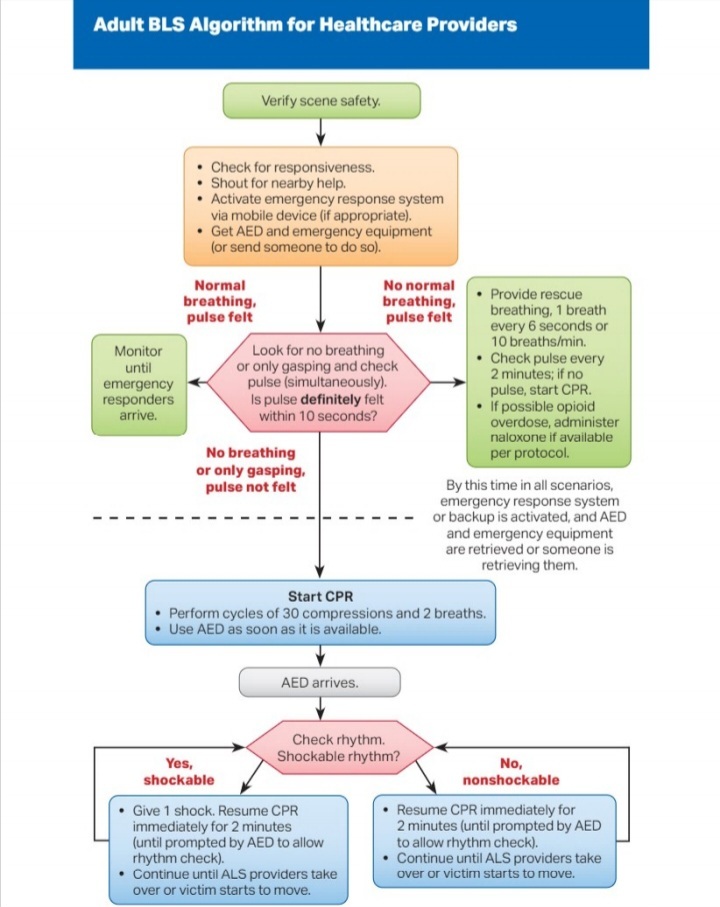(Images can be enlarged if needed)

Cardiac arrest, also known as Sudden Cardiac Arrest, is when the heart stops beating suddenly. The lack of blood flow to the brain and other organs can cause a person to lose consciousness, become disabled or die if not treated immediately.
The terms ‘heart attack’ and ‘cardiac arrest’ are often used interchangeably, but these are two different heart conditions.
A heart attack occurs when there is a blockage in the arteries that stops blood flow in the heart. Due to the lack of blood and oxygen flowing in the heart, the heart muscle tissue will become damaged. Heart attacks can increase the risk for cardiac arrest because heart attacks can alter electrical signals in the heart.
CPR – or Cardiopulmonary Resuscitation – is an emergency lifesaving procedure performed when the heart stops beating. Immediate CPR can double or triple chances of survival after cardiac arrest.
If someone experiences cardiac arrest, they need immediate treatment to increase the flow of oxygen-rich blood to their organs. CPR is the compression over the chest to manually pump a patients heart. Rescue breaths are preformed to provide oxygen to the body.
During CPR, proper hand placement on the lower half of the sternum is crucial. Placing hands over the sternum ensures effective chest compressions directly above the heart, optimizing blood circulation throughout the body.
According to the American Heart Association (AHA), the overall survival rate for out-of-hospital cardiac arrest is around 10%. However, survival rates can be improved if bystander CPR is started immediately. Studies have shown that bystander CPR increases the chances of survival for someone experiencing cardiac arrest. In fact, the AHA reports that survival rates increases to 40% or higher when bystander CPR is performed promptly. The surival rate is between 24% and 40% for those that happen in the hospital, according to the report published online in the Emergency Medicine Journal.
CPR is preformed between 100 - 120 beats per minute. Famously Staying Alive by the Bee Gees is the same beat. A large list of songs with the correct BPM can be found here
![]() The American Red Cross gives the following list of steps to asses if CPR is needed and how to preform:
The American Red Cross gives the following list of steps to asses if CPR is needed and how to preform:
1 CHECK the scene for safety, form an initial impression and use personal protective equipment (PPE)
2 If the person appears unresponsive, CHECK for responsiveness, breathing, life-threatening bleeding or other life-threatening conditions using shout-tap-shout
3 If the person does not respond and is not breathing or only gasping, CALL 9-1-1 and get equipment, or tell someone to do so
4 Kneel beside the person. Place the person on their back on a firm, flat surface
5 The American Red Cross CPR guidelines recommend 100 to 120 chest compressions per minute, 30 at a time. Remember these five points:
Hand position: Two hands centered on the chest
Body position: Shoulders directly over hands; elbows locked
Compression depth: At least 2 inches
Rate of compressions: 100 to 120 per minute
Allow chest to return to normal position after each compression
6
Give 2 breaths
Open the airway to a past-neutral position using the head-tilt/chin-lift technique Pinch the nose shut, take a normal breath, and make complete seal over the person’s mouth with your mouth. Ensure each breath lasts about 1 second and makes the chest rise; allow air to exit before giving the next breath Note: If the 1st breath does not cause the chest to rise, retilt the head and ensure a proper seal before giving the 2nd breath If the 2nd breath does not make the chest rise, an object may be blocking the airway
7 Continue giving sets of 30 chest compressions and 2 breaths. Use an AED as soon as one is available! Minimize interruptions to chest compressions to less than 10 seconds.
Sources:
https://www.hopkinsmedicine.org/health/conditions-and-diseases/cardiac-arrest
https://cpr.heart.org/en/resources/cpr-facts-and-stats
https://www.mycprcertificationonline.com/blog/cpr-success-rate
Instructional images from the AHS Basic Life Support Manual (2020)
Join our public Matrix server! https://matrix.to/#/#tracha:chapo.chat
As a reminder, be sure to properly give content warnings and put sensitive subjects behind proper spoiler tags. It's for the mental health of not just your comrades, but yourself as well.
Here is a screenshot of where to find the spoiler button.



I was gonna try adding squats
that's a good plan, when you're feeling better ig? squats are great, my legs are getting all purty (i usually need a couple days in between workouts, either 1 or 2, sometimes i can only really do 1 a week) (edit: obv not the same as your situation)
Purty legs When I'm feelin better yeah. I have a ton of lower body strength already but why not more right?
When I'm feelin better yeah. I have a ton of lower body strength already but why not more right?
Below the waist is the only musculature that wasn't ruined by chronic pain so I do wanna build it up more. also my butt will look even better
makes sense
fuck yeah, my butt is a big source of gender euphoria (and i mean it's cute, i like looking at certain parts of myself) for me, i just realized. its nice to see it all perky when i'm in all tooooned and stuff
(this is not related and not as bad, but i randomly decided to play an hour of violin a few days ago, and it took 2 days for the pain to set in, i woke up this morning and was like "wow fuck my shoulders fucking don't want to move and my fingers are a bit tingly if i try anyway," sad...)
Uhhhhh standing in the mirror with your waist cranked around at weird angles to see your butt and look at how good it is? Mood??? Also ngl, despite all the padding it still hurts my ass to sit too long, so maybe exercise will make it firmer, lol
Oh, do you stretch much before playing, if possible? Fingers there might not be much for but maybe your shoulders could suck less?
BIG MOOD. yes i do this lmfao, just did, in a break between meetings lol, some days i love my legs and i take every minute to inspect them that i can
I get this too actually. I usually blame the chairs, I have a desk setup in the dining room and even though the dining chairs are cushy at first after a while it gets so painful that it really really hurts to move because I go totally numb.
My office chair is a $3bn thing I took from the work office when the pandemic started, it is luxurious ... don't know what i'd do without it.
Good thinking... I should try this ... It's hard to judge how much pain I will be in multiple days before but it probably would help to stretch before doing any kind of music. I also play sporadically (due to the pain) which means I don't have the shoulder muscles developed.